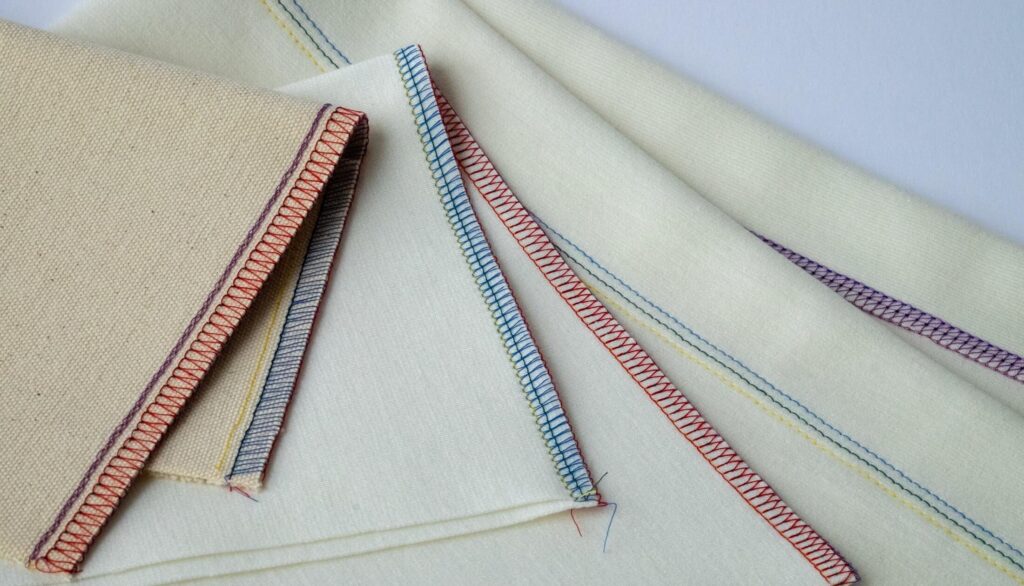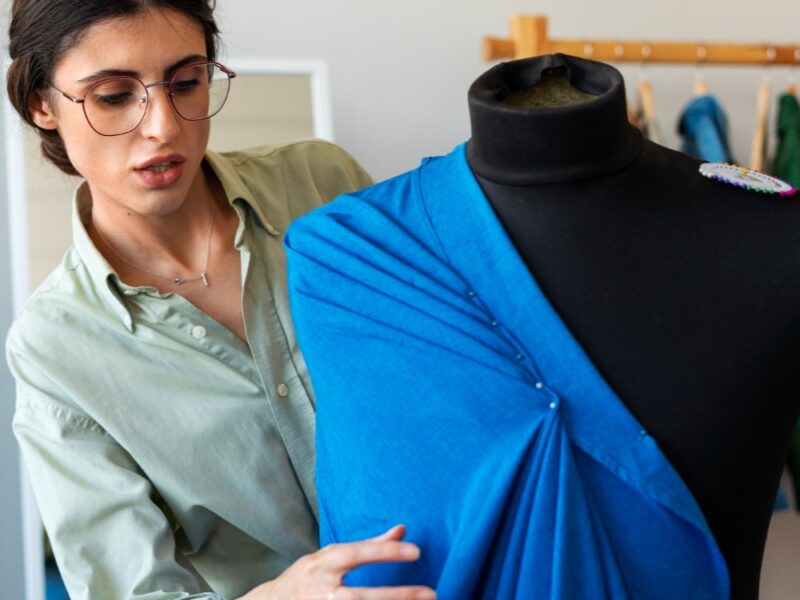Stitching and Seams in Fashion Design Studies…
Fashion construction encompasses a range of Stitching, sewing techniques and specialised machines. Here’s a detailed breakdown of stitching, machines, and stitches.

1. Stitching & Types of Sewing Machines
Stitching is the fundamental process of assembling fabric by threading pieces together using different methods.
Types of Sewing Machines
- Lockstitch Machine – Standard machine used for basic stitching; creates durable stitches.
- Overlock (Serger) Machine – Used for finishing edges and preventing fraying; common in industrial sewing.
- Chain Stitch Machine – Used for decorative stitching and stretch fabrics.
- Coverstitch Machine – Produces professional hems in knitwear (e.g., T-shirts).
- Embroidery Machine – Specialised for decorative stitching and monograms.
- Walking Foot Machine – Used for sewing thick fabrics like leather or quilts.
- Bartack Machine – Strengthens stress points in garments (pockets, belt loops).
2. Types of Stitches
Each stitch serves a different purpose in garment construction.
- Straight Stitch – Basic, clean stitch used for most seams.
- Zigzag Stitch – Prevents fraying and allows for slight stretch.
- Backstitch – Reinforces stitching at the beginning and end.
- Overlock Stitch – Finishes edges neatly (used in mass production).
- Blind Hem Stitch – Invisible hem for formal wear.
- Decorative Stitches – Used for embellishments (e.g., embroidery patterns).
- Stretch Stitch – Used for elastic fabrics like jersey or spandex.
3. Types of Seams
Seams hold garments together and influence flexibility and durability.
- Plain Seam – Basic seam found in most garments.
- French Seam – Neatly enclosed seam for delicate fabrics.
- Flat-Felled Seam – Extremely durable seam found in jeans.
- Lapped Seam – Used in leather and non-fray materials.
- Bound Seam – Uses bias tape for reinforcement (common in jackets).
- Overlocked Seam – Prevents edges from unravelling in mass production.

Here are real-life examples for each topic in fashion construction:
1. Stitching & Sewing Machines
Example: Lockstitch Machine – Levi’s Jeans
Levi’s uses industrial lockstitch machines to create strong, long-lasting seams in their iconic denim. The sturdy stitching ensures durability, allowing jeans to withstand years of wear.
Example: Overlock Machine – Zara’s Fast Fashion
Zara employs overlock machines for rapid mass production. These machines neatly finish fabric edges, preventing fraying and ensuring a polished look.
Example: Embroidery Machine – Ralph Lauren Polo Shirts
Ralph Lauren uses computerised embroidery machines to stitch the signature Polo Ralph Lauren logo onto garments, ensuring consistent quality across all products.
2. Types of Stitches
Example: Blind Hem Stitch – Chanel Haute Couture
In Chanel couture gowns, blind hem stitching is used to create nearly invisible hems, keeping the garment’s finish sleek and seamless.
Example: Zigzag Stitch – Nike Sportswear
Nike uses zigzag stitching in sportswear, allowing the garments to stretch and move with the athlete’s body while maintaining durability.
Example: Decorative Stitches – Indian Handloom Sarees
Traditional Indian handloom sarees feature decorative stitches created by artisans using specialised sewing techniques.
3. Types of Seams
Example: Flat-Felled Seam – Denim Jeans
Denim brands like Wrangler and Levi’s use flat-felled seams to reinforce jeans, preventing tearing along stress points.
Example: French Seam – Luxury Silk Blouses
Luxury brands such as Gucci use French seams in silk blouses for a clean, refined finish that avoids raw edges.
Example: Overlocked Seam – H&M Casual Wear
H&M employs overlocked seams in mass-produced clothing to create durability while maintaining affordability.


